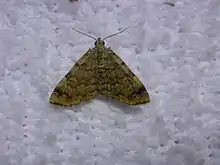Idia americalis
Idia americalis, the American idia or American snout, is a litter moth of the family Erebidae. The species was first described by Achille Guenée in 1854. It is commonly found in moist forests in North America, ranging from southern Canada to Florida and Texas. It is nocturnal and can be lured by sugar baits and light traps.
| Idia americalis | |
|---|---|
 | |
| Scientific classification | |
| Kingdom: | Animalia |
| Phylum: | Arthropoda |
| Class: | Insecta |
| Order: | Lepidoptera |
| Superfamily: | Noctuoidea |
| Family: | Erebidae |
| Genus: | Idia |
| Species: | I. americalis |
| Binomial name | |
| Idia americalis (Guenée, 1854) | |
| Synonyms | |
| |
The American idia has forewings that range in color from grey to beige or light brown, darker toward the outer margin of the wing, with darker scalloped lines crossing the wings laterally. A dark terminal line is located at the base of the wing's fringe. All have a small bronze or brown spot located near the edge of the forewing. The hindwing is a lighter grey than the forewing and also has darker scalloped lines. Darker specimen can be dark grey or brown. The thorax and abdomen are smoothly scaled and the tibia is hairless. Female antenna are simple while male antenna are biciliate; otherwise, the sexes look similar. [1] The caterpillar is brown with dark brown spots, a black head, and has small white hairs along its sides. [2]
The wingspan ranges from 20-30 mm. Adults are on wing from May to October. They can produce two or more broods per year. [3]
It can be differentiated from similar species, such as the common idia, by a row of dark marks located on the anterior forewing. [4] Idia americalis specimen may be mistaken for a small geometrid moth.
The larvae feed on lichen and detritus, including dead leaves. They may also function as detritivores in ant nests. Adults often feed on lichens attached to tree trunks. [3]
Known host plants
- Leguminosae - legume, pea, and bean family
- Lichenes - lichen
- Angelica
- Pseudotsuga menziesii - Douglas fir
- Picea - spruce
See Robinson, G.S. et al. [5]
References
- "PNW Moths | Idia americalis". pnwmoths.biol.wwu.edu. Retrieved 2020-11-30.
- "American Idia". Fontenelle Forest Nature Search. 2018-12-26. Retrieved 2020-11-30.
- "American Idia". www.insectidentification.org. Retrieved 2020-11-30.
- "Species Idia americalis - American Idia - Hodges#8322". bugguide.net. Retrieved 2020-11-30.
- "CATERPILLAR HOSTPLANTS DATABASE - The natural History Museum". www.nhm.ac.uk. Retrieved 2020-11-30.
- "930469.00 – 8322 – Idia americalis – American Idia Moth – (Guenée, 1854)". North American Moth Photographers Group. Mississippi State University. Retrieved January 27, 2020.
- "American Idia". Fontenelle Forest Nature Search. 2018-12-26. Retrieved 2020-11-30. [1]
- "American Idia". www.insectidentification.org. Retrieved 2020-11-30. [2]
- McLeod, Robin (September 18, 2018). "Species Idia americalis - American Idia - Hodges#8322". BugGuide. Retrieved January 27, 2020. [3]
- "PNW Moths | Idia americalis". pnwmoths.biol.wwu.edu. Retrieved 2020-11-30. [4]
- Robinson, E. & Schmidt, B. C. "Species Details Idia americalis". University of Alberta Museums. E.H. Strickland Entomological Museum. Retrieved November 9, 2020.
- Robinson, G.S., P.R. Ackery, I.J. Kitching, G.W. Beccaloni & L.M. Hernández (2010). HOSTS – A Database of the World's Lepidopteran Hostplants. Natural History Museum, London". [5]
- Wagner, David L.; Schweitzer, Dale F.; Sullivan, J. Bolling & Reardon, Richard C. (2011). Owlet Caterpillars of Eastern North America. Princeton University Press. ISBN 978-0691150420.